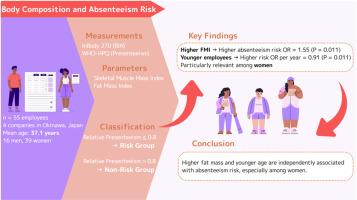员工身体成分与旷工风险
IF 2.6
Q3 NUTRITION & DIETETICS
引用次数: 0
摘要
背景与目的:出勤(定义为由于疾病或症状而降低工作绩效)和缺勤(定义为由于生病或受伤而缺勤)对工人生产率构成重大挑战。本研究旨在研究员工旷工风险与身体成分之间的关系,包括骨骼肌质量指数和脂肪质量指数(FMI)。方法:采用横断面研究方法,于2024年5月至7月对4家公司的55名员工进行调查。使用生物电阻抗分析评估参与者的身体组成,使用世界卫生组织健康与工作绩效问卷(WHO-HPQ)测量出勤率。骨骼肌质量指数和脂肪质量指数(FMI)作为主要身体成分参数进行评估。进行Logistic回归分析以确定与旷工风险相关的因素,定义为相对出勤得分≤0.8。结果:旷工风险组的FMI显著高于无旷工风险组,尤其是女性参与者。多因素logistic回归分析显示,较高的FMI(比值比[OR] = 1.55, 95%可信区间[CI] = 1.11-2.17, P = 0.011)和较年轻的年龄(OR = 0.91, 95% CI = 0.85-0.98, P = 0.011)与旷工风险独立相关。结论:较高的FMI与缺勤风险增加独立相关,特别是在女性中,年轻员工更有可能出现缺勤风险。这些联系可为工作场所卫生战略提供信息;然而,由于横断面设计,无法得出因果推论。未来的纵向研究需要确定改善身体组成是否会减少缺勤。本文章由计算机程序翻译,如有差异,请以英文原文为准。

Body composition and absenteeism risk among employees
Background & aims
Presenteeism, defined as reduced work performance owing to illness or symptoms, and absenteeism, defined as absence from work owing to illness or injury, pose significant challenges to worker productivity. This study aimed to examine the association between the risk of absenteeism and body composition, including skeletal muscle mass index and fat mass index (FMI), among employees.
Methods
A cross-sectional study was conducted with 55 employees from four companies between May and July 2024. The participants’ body compositions were assessed using bioelectrical impedance analysis, and presenteeism was measured using the version of the World Health Organization Health and Work Performance Questionnaire (WHO-HPQ). Both skeletal muscle mass index and fat mass index (FMI) were evaluated as key body composition parameters. Logistic regression analysis was performed to identify factors associated with absenteeism risk, defined as a relative presenteeism score of ≤0.8.
Results
The FMI was significantly higher in the absenteeism risk group than in the non-absenteeism risk group, particularly among women participants. Multivariate logistic regression analysis revealed that higher FMI (odds ratio [OR] = 1.55, 95 % confidence interval [CI] = 1.11–2.17, P = 0.011) and younger age (OR = 0.91, 95 % CI = 0.85–0.98, P = 0.011) were independently associated with absenteeism risk.
Conclusions
Higher FMI was independently associated with increased absenteeism risk, especially in women, and younger employees were more likely to be at risk of absenteeism. These associations may inform workplace health strategies; however, due to the cross-sectional design, no causal inferences can be drawn. Future longitudinal research is needed to determine whether improving body composition leads to reductions in absenteeism.
求助全文
通过发布文献求助,成功后即可免费获取论文全文。
去求助
来源期刊

Clinical nutrition ESPEN
NUTRITION & DIETETICS-
CiteScore
4.90
自引率
3.30%
发文量
512
期刊介绍:
Clinical Nutrition ESPEN is an electronic-only journal and is an official publication of the European Society for Clinical Nutrition and Metabolism (ESPEN). Nutrition and nutritional care have gained wide clinical and scientific interest during the past decades. The increasing knowledge of metabolic disturbances and nutritional assessment in chronic and acute diseases has stimulated rapid advances in design, development and clinical application of nutritional support. The aims of ESPEN are to encourage the rapid diffusion of knowledge and its application in the field of clinical nutrition and metabolism. Published bimonthly, Clinical Nutrition ESPEN focuses on publishing articles on the relationship between nutrition and disease in the setting of basic science and clinical practice. Clinical Nutrition ESPEN is available to all members of ESPEN and to all subscribers of Clinical Nutrition.
 求助内容:
求助内容: 应助结果提醒方式:
应助结果提醒方式:


